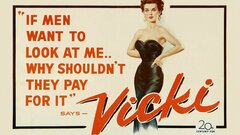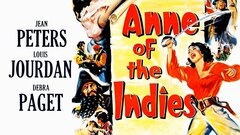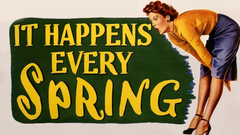Jean Peters

Actress
Birth Date: October 15, 1926
Death Date: October 13, 2000 — 73 years old
Birth Place: Canton, Ohio
Spouses: Howard Hughes
One of many photogenic young women recruited by Hollywood during the 1940s, Jean Peters jumped right into lead roles her first time out via the Technicolor epic "Captain from Castile" (1947). Gifted with the sort of face that prompted studio executives to offer instant movie contracts, Peters was never very comfortable with the sort of beauty queen image Fox wanted and was essentially a tomboy off-screen. While Peters often expressed disdain for the parts Fox assigned, she was almost invariably able to fulfill their requirements and registered favorably in pictures as varied as the comedic "It Happens Every Spring" (1949), Elia Kazan's superb biopic "Viva Zapata!" (1952), the film noir classic "Pickup on South Street" (1953), and the picturesque romantic drama "Three Coins in the Fountain" (1954).
Ultimately, however, she decided to retire from acting in the mid-1950s at the young age of 29, despite having many more viable years as a leading lady. She eventually resurfaced after more than two decades out of the spotlight, but only appeared in a handful of television projects before retreating back into private life.
A native of Canton, OH, Elizabeth Jean Peters was born on Oct. 15, 1926. Peters' father died when she was 10 and she was largely raised by her mother on the family farm. A Methodist, Peters graduated from East Canton High School and began her post-secondary education at the University of Michigan, but ultimately finished up at Ohio State. Her goal was to become a teacher, but that all changed when a friend covertly entered her in the Miss Ohio State pageant. Peters was chosen for the honor and her new title included a contract with 20th Century Fox.
Upon relocating to Los Angeles, Peters was given a screen test and made her film debut as the female lead in no less than the Tyrone Power period adventure "Captain from Castile" (1947). The lavish adventure was a box office disappointment in relation to its huge budget, but still offered a very well-publicized vehicle for a newcomer. In a 1948 issue of Photoplay, readers voted Peters the actress most likely to become a star. The lovely ingénue also attracted the attentions of notorious billionaire playboy Howard Hughes.
The pair soon began dating and Hughes proposed the following year, but Peters declined, stating that she was too young for marriage.
Peters was not the usual contract player beauty of the time and regularly took issue with the sort of roles given to her. An unrepentant tomboy, she refused to adopt the sort of glamorous look in public that was de rigueur for leading ladies. In fact, Peters was most happy watching baseball games and was likely delighted when cast in "It Happens Every Spring" (1949), a pleasing comedy about a scientist (Ray Milland) whose new invention makes him an unbeatable major league pitcher.
In another departure from the norm for most movie stars, Peters was never late for shooting and was affectionately known among the crews she worked with as "Punctual Pete." Pictures like "Love That Brute" (1950), "As Young as You Feel" (1950), and "Take Care of My Little Girl" (1951) offered her few challenges, but perhaps more so than any other actress on the Fox lot, Peters was a perfect choice to play female pirate captain "Anne of the Indies" (1951) and responded with a vivid and entertaining performance.
Regardless, Peters continued to butt heads with the studio, which finally put her on suspension. A savior emerged in the form of director Elia Kazan, who decided that it was Peters he wanted to star opposite Marlon Brando in his historical biopic "Viva Zapata!" (1952). She did an admirable job as the famous Mexican revolutionary's love interest and Fox began to make regular use of Peters once again, notably in "Lure of the Wilderness" (1952), a Technicolor remake of the studio's 1941 production "Swamp Water".
The year 1953 proved to be an especially busy one for Peters. She co-starred with rising Fox starlet Marilyn Monroe and Joseph Cotten in the gripping thriller "Niagara" (1953) and graced a trio of film noir thrillers. She was reteamed with Cotten in "A Blueprint for Murder" (1953) and had the title part in "Vicki" (1953), a new take on the company's Betty Grable vehicle "I Wake Up Screaming" from 1941. Most notably, Peters had one of her best roles from that period in Sam Fuller's superbly crafted thriller "Pickup on South Street" (1953) as an inadvertent aid to Communist spies.
Off-screen, she also journeyed with fellow performers to Korea and entertained American troops stationed there. Other roles were not always as perfect a fit. Although Peters was well-suited to outdoor adventures, she was rather miscast as the Native American wife of Burt Lancaster in the Western "Apache" (1954) and did not have much to do as the romantic interest for Robert Wagner in "Broken Lance" (1954). She also reportedly had little interest in the part she was assigned for "Three Coins in the Fountain" (1954), but the lovely romance/Italian travelogue went on to be a major success. The inspirational biographical drama "A Man Called Peter" (1955) turned out to be her swan song. Weary of clashing with the studio, Peters decided to leave the business.
She had continued to see Howard Hughes on and off during the previous eight years, while he quite openly dated other actresses - including Terry Moore, who later claimed to have tied the knot with Hughes in Mexico in 1949 - but was fed up with his reluctance to marry her. Instead, Peters walked down the aisle with Texas oilman Stuart Cramer III only a few days after first meeting him on an airplane. Their time together proved almost equally short when they separated after little more than a month. Although the pair eventually reconciled, problems arose once again and they divorced after 18 months. Peters claimed mental cruelty as the cause, but there was much speculation that Hughes was the true catalyst.
Whatever the case, the billionaire finally agreed to wed Peters at the beginning of 1957. In accordance with his wishes, she abandoned her acting career and largely disappeared from view. Peters never commented on her days with Hughes, but it was speculated that the marriage was far from conventional, due to his pronounced eccentricities and habit of having her followed at virtually all times by men in his employ.
Under the name Elizabeth Peters, she took Sociology classes at UCLA in the1960s, but left when news got out about her true identity. Her union with Hughes officially ended in 1971 and Peters received a settlement of $70,000 a year for life. Two months after the papers were signed, she wed veteran Fox producer and executive Stanley Hough and the couple remained together until his death in 1990.
After a gap of almost two decades, Peters returned to the world of acting with a role in the made-for-TV production "Winesburg, Ohio" (PBS, 1973). She also joined fellow veterans Kirk Douglas and Anne Baxter in the miniseries "Arthur Hailey's The Moneychangers" (NBC, 1976) and appeared as Priscilla in the biblical drama "Peter and Paul" (CBS, 1981), which was produced and co-written by Hough. Her closing credit came in a 1988 episode of the hit Angela Lansbury series "Murder, She Wrote" (CBS, 1984-1996).
Peters eventually did obtain the teaching degree she had sought earlier in life and also spent part of her later years doing charity work. She died of leukemia on Oct. 13, 2000, two days before what would have been her 74th birthday.
By John Charles
Credits

Murder, She WroteStream

Peter and Paul

Arthur Hailey's The Moneychangers

The Moneychangers

A Man Called Peter

ApacheStream

Three Coins in the FountainStream

Broken LanceStream

A Blueprint for MurderStream

Pickup on South StreetStream

NiagaraStream

VickiStream

Viva Zapata!Stream

Lure of the Wilderness

Wait 'Til the Sun Shines, Nellie

O. Henry's Full HouseStream

Anne of the IndiesStream

As Young as You Feel

La Flibustière des Antilles

Love That Brute

It Happens Every SpringStream

Deep Waters
























































































![O. HENRY'S FULL HOUSE, Jean Peters, Anne Baxter [The Last Leaf], 1952, TM and Copyright (c) 20th Century-Fox Film Corp. All Rights Reserved](https://media.baselineresearch.com/images/114204/114204_small.jpg)




































